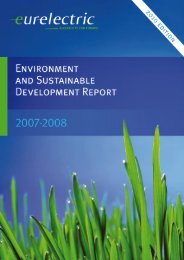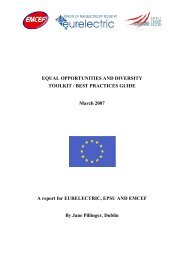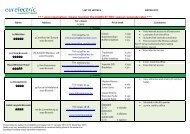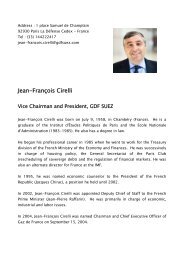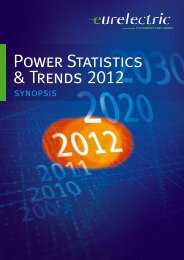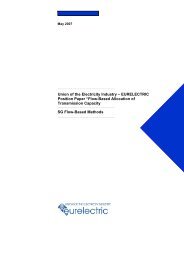Power Statistics - 2010 Edition - Full Report - Eurelectric
Power Statistics - 2010 Edition - Full Report - Eurelectric
Power Statistics - 2010 Edition - Full Report - Eurelectric
Create successful ePaper yourself
Turn your PDF publications into a flip-book with our unique Google optimized e-Paper software.
general information 1.3 Comments<br />
Thus the share of taxes and levies on electricity price arose from 25% in 1998 to 40% in 2009 for private<br />
households and from 2% to 21% for industrial customers. Due to the economic crisis and according to<br />
the declining fuel prices, electricity prices for industrial consumers fell as well since the end of 2008,<br />
but prices for private households were still rising, because of the growing subsidization of renewable<br />
energies which are financed via the electricity price and because of the common practice to procure<br />
these deliveries early in the future market, so the price peaks at the wholesale market of the year 2008<br />
are still included in price calculations for private consumers.<br />
The subsidisation of renewable energies due to Renewable Energy Sources Act (Erneuerbare-Energien-<br />
Gesetz (EEG)) led to an increase of the so called EEG-contribution (EEG-Umlage) as part of the retail<br />
electricity price up to 2,047 ct/kWh in <strong>2010</strong>. For 2011 an increase to clearly more than 3 ct/kWh, maybe<br />
close to 4 ct/kWh is expected.<br />
Looking at customer switching, results from a customer survey in September <strong>2010</strong> show the following:<br />
21.7% of private households have switched their supplier since 1998, more than 40% have chosen a<br />
better contract with their existing supplier.<br />
Almost every Industrial consumers has at least once chosen a new supplier or negotiated a better<br />
contract with its existing supplier.<br />
Wholesale market<br />
Apart from an active OTC market for electricity sales, the European Energy Exchange (EEX) in Leipzig<br />
gains more and more importance.<br />
The EEX in Leipzig – emerged from the European Energy Exchange in Frankfurt/Main and the Leipzig<br />
<strong>Power</strong> Exchange – resumed work in July 2002. The main activities cover the spot market, the futures<br />
market and the clearing of OTC dealings.<br />
The index underlying the futures market is the Phelix price index representing the arithmetic means of<br />
the 24 single-hour prices for the respective next day on exchange’s spot market.<br />
In 2008, 1,319 TWh (2007: 1,273 TWh) were traded at the EEX, whereas 154 TWh or around 30% of the<br />
German net electricity consumption account for the spot market and 1,165 TWh are traded in the futures<br />
market. In February 2009, the EEX had 219 member companies from 19 nations, whereas two-thirds are<br />
non-German.<br />
The EEX is a regulated market subject to the German Exchange Act. It is supervised by three different<br />
institutions: the Exchange Council, the Ministry of Economic Affairs of the Free State of Saxony and the<br />
German Financial Supervisory Authority (Bundesanstalt für Finanzdienstleistungsaufsicht BAFin).<br />
Today the exchange prices are the benchmark for the whole market including OTC wholesale and<br />
retail business.<br />
In the field of power trading EEX cooperates with the French <strong>Power</strong>next SA. EEX holds 50% of the<br />
shares in the joint venture EPEX Spot SE based in Paris which operates short-term trading in power – the<br />
so-called Spot Market – for Germany, France, Austria and Switzerland. German and French power<br />
derivatives trading is concentrated within EEX <strong>Power</strong> Derivatives GmbH, a majority-owned EEX subsidiary<br />
with headquarters in Leipzig.<br />
SPAIN (es)<br />
GENERAL INFORMATION<br />
Data General Information<br />
In preparing this report, the current economic crisis was taken into account.<br />
In general the Spanish data covers the overall country, that is, both the mainland interconnected system<br />
and the island’s systems.<br />
Data shown in Table 1.3 relates to the number of employees, the annual investments and the turnover<br />
corresponds to the UNESA’s member companies. Investment data includes the investments of electricity<br />
companies on renewable energy sources, but they do not include investments on transmission network.<br />
The capacity balance, Table 4.1, does not refer to the overall country but to the mainland interconnected<br />
system.<br />
<strong>Power</strong> <strong>Statistics</strong> – <strong>2010</strong> <strong>Edition</strong> – <strong>Full</strong> <strong>Report</strong> 37



